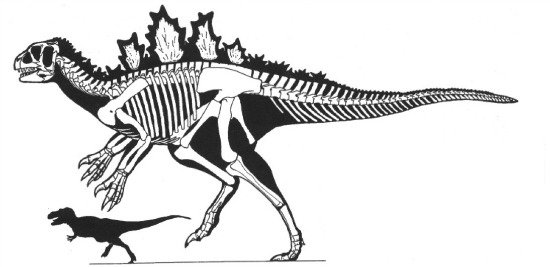What Kind of Dinosaur is Godzilla?
Everyone knows that Godzilla is a radioactive dinosaur, but just what sort of dinosaur is the famous monster?
![]()

Paleontologist Kenneth Carpenter’s conception of Godzilla, shown alongside a 40-foot Tyrannosaurus. From Carpenter, 1998.
Godzilla certainly puts the “fiction” in sci-fi. When you’re dealing with an amphibious dinosaur the size of a mountain that is effectively a biological nuclear reactor, it’s advisable to leave the monster as a symbol of wanton atomic destruction and not worry too much about scientific accuracy. But with the upcoming American reboot of the long-running franchise, I couldn’t help but wonder about the one aspect of Godzilla where paleontology might have something to contribute–just what sort of dinosaur Godzilla is.
Everyone knows that Godzilla is a mutated something-o-saurus. Just what sort of creature the aberration started out as varies from one canonical storyline to another. During the 1990s run of the Godzilla series, for example, the movie Godzilla vs. King Ghidorah showed that Godzilla mutated from a late-surviving theropod dinosaur. The carnivore looked like the old, dumpy restorations of Tyrannosaurus from the mid-20th century, and, no surprise, the fictional dinosaur is known as Godzillasaurus. (Not to be confused with the real dinosaur given the name “Gojirasaurus,” which is probably a synonym of Coelophysis.)
But in a light-hearted article published in 1998, paleontologist Ken Carpenter tried to divine what sort of dinosaur Godzilla is, based upon the kaiju’s anatomy. This was no simple task. Godzilla has traits that evolved multiple times among different groups of large carnivorous theropods, creating a strange dinosaurian mosaic. Not to mention all those radiation-spurred mutations.
Still, the monster’s anatomy holds enough clues to place him within a particular part of the dinosaur family tree. Godzilla’s long arms and four fingers on each hand indicate that the “Big Guy” is a basal theropod, or, in other words, belongs to one of the early branches of the group’s family tree. And even though the bony fins along Godzilla’s back are reminiscent of the herbivore Stegosaurus, Carpenter pointed out that some theropods–such as Ceratosaurus–had less-flashy bony armor along their spines. Perhaps the prominent ornaments on Godzilla were highly-modified versions of body armor that was more subtle among his ancestors.
More than anything else, though, Carpenter pointed to Godzilla’s head as the key to the mutant dinosaur’s identity. Godzilla has a short, deep skull reminiscent of a group of theropods called abelisaurids–dinosaurs such as Carnotaurus and Skorpiovenator that were cousins of Ceratosaurus. (In fact, the abelisaurids were a subgroup within the Ceratosauria.) Combined with the finger count and osteoderms, Carpenter noted, the creature’s skull suggests that Godzilla is some sort of ceratosaur–perhaps even a form that smooths the transition between more archaic ceratosaurs and the deep-skulled abelisaurids. Exactly how such a strange dinosaur survived to the modern era, and how radioactivity created such a monstrosity, are questions best left in movie mythology.
For a more detailed look at Godzilla’s improbable biology, see this post by paleontologist Darren Naish.
Reference:
Carpenter, K. (1998) A dinosaur paleontologist’s view of Godzilla. In Lees, J. D. & Cerasini, M. (eds) The Official Godzilla Compendium. Random House (New York), pp. 102-106.
/https://tf-cmsv2-smithsonianmag-media.s3.amazonaws.com/accounts/headshot/RileyBlack.png)
/https://tf-cmsv2-smithsonianmag-media.s3.amazonaws.com/accounts/headshot/RileyBlack.png)